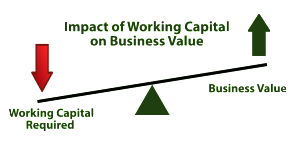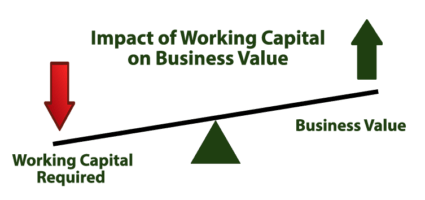Everybody knows that a company’s revenue and profits play a big role in its value. After all, a multiple of EBITDA (earnings before interest, taxes, depreciation and amortization) is one way to estimate the value a business. However, valuation is not nearly as simple as that.
One way to improve your multiple and increase the value of your business is to improve cash flow and decrease working capital requirements. This steps will also make your business stronger regardless if when or if you plan to sell it.
Cash vs. Profits
 Cash flow is different than profits in that it measures the cash coming in and out of your business rather than an accounting interpretation of your profit and loss. For example, if you charge $10,000 upfront for a service that takes you three months to deliver, you recognize $3,333 of revenue per month on your profit and loss statement for each of the three months it takes you to deliver the work.
Cash flow is different than profits in that it measures the cash coming in and out of your business rather than an accounting interpretation of your profit and loss. For example, if you charge $10,000 upfront for a service that takes you three months to deliver, you recognize $3,333 of revenue per month on your profit and loss statement for each of the three months it takes you to deliver the work.
But since you charged upfront, you get all $10,000 of cash on the day your customer decides to buy. This positive cash flow cycle improves your company’s valuation because when it comes time to sell your business, the buyer will have to write two checks: one to you, the owner, and a second to your company to fund its working capital – the cash your company needs to fund its immediate obligations like payroll, rent, etc.
The trick is that both checks are drawn from the same bank account. Therefore, the less the acquirer has to inject into your business to fund its working capital, the more money it has to pay you for your company.
The inverse is also true.
If your company consumes cash, an acquirer is going to calculate that she needs to inject a lot of working capital into your business on closing day, which will deplete her resources and lessen the check she writes to you.
How To Improve Your Cash Flow
There are many ways to improve your cash flow – and therefore, the value of your business. Here are a few key ones.
Some landscape services businesses bill their customers at the end of the month for the services provided that month. Others bill their customers at the beginning of the month for the services to be provided during the month. On average, both sets of customers take about the same number of days to pay, so companies that bill at the beginning of the month generate more cash and may be worth more as well. It isn’t easy to switch from the end of the month to the first of the month, but you might consider putting each new account on a bill at the beginning of the month cycle. In this way, you can gradually increase your cash flow and the value of your business.
Another way to increase cash flow relates to how you pay your bills. In my experience, many landscape business owners pay their bills immediately when they are received which may be several weeks in advance of the due date. I am not advocating not paying your bills, but timing the payment of those bills when they are due will improve cash flow and contribute to increasing the value of your business.
One often overlooked tactic is to spend less on the machines your company needs to operate.
In the restaurant business, for example, there is an often repeated truism that it takes three bankruptcies at a single location before any restaurant can make money. The first owner of the restaurant walks in and – with all of the typical optimism of a new entrepreneur – pays cash for a brand new commercial kitchen complete with fancy stove, commercial grade walk-in coolers, etc., as well as all new dishware, pots and pans, thus depleting his cash reserves before opening night. Within a year, the restaurant owner runs out of cash and declares bankruptcy.
Then along comes a second entrepreneur who decides to set up her restaurant at the same location and buys all of the shiny new equipment from owner number one’s creditors for 70 cents on the dollar, figuring she has made a wonderful deal. But the outlay of cash is still too great and she too is out of business within a year.
It’s not until the third owner comes along that the location actually survives. He saves his cash by buying all of the equipment off the second owner for 10 cents on the dollar.
The moral of the story is: find a way to reduce the cash you spend on equipment, however you can. Can you buy your gear used on sites like eBay? Can you share a very expensive piece of machinery with another non-competitive business? Can you rent instead of buying?
In the landscape industry, some business owners prefer relatively new equipment and others prefer to buy used equipment and keep it for a long time. Typically, they have mechanics on staff to keep the equipment in good shape and many clients won’t even be able to tell the difference. Both camps feel pretty strongly about which is better. I don’t have an opinion, but I do know that capital expenditures affect cash flow and cash flow affects value. It depends on many factors which choice products better cash flow now and in the future, but is worth some analysis in your particular situation.
One more caution, not only does your actual cash flow affect your business’s value, so does what is expected to happen after an acquisition. Some business owners defer maintenance and capital expenditures in advance if selling their businesses in the belief that it will increase the value of their business. That doesn’t really work because a buyer will likely be looking forward to see what cash requirements will be going forward. If the buyer will have to increase capital expenditures to update a fleet, they will most assuredly factor that into what they will pay for your business.
Profits are an important factor in your company’s value but so too is the cash your company generates. Improving cash flow can help you move your multiple and get a higher value for your business and improve your business in the mean time.

